Petra is one of the Seven Wonders of the Modern World and a UNESCO World Heritage Site. It features on most “must see before you die” lists. The ancient city, carved into the mountains around 2000 years ago, is incredible in so many ways, so settle in and enjoy this taste of being there! For those who plan to go, hopefully my bullet-pointed suggestions for how to tackle Petra in 2 days will be helpful.
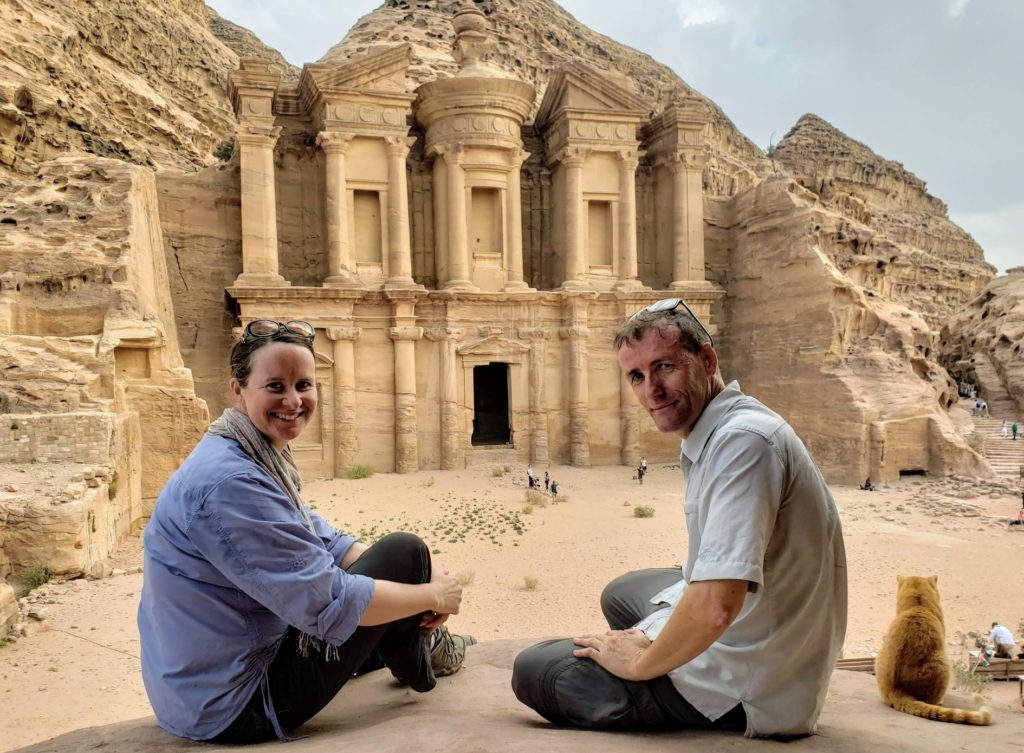
Petra is overwhelmingly huge and well worth joining the thousands of other tourists who visit every day. We were two of 1.1 million visitors in 2019! When purchasing the Jordan Pass – highly recommended for any tourist coming to Jordan – you need to choose whether you want to spend 1, 2 or 3 days in Petra. We opted for 2.
If you are fit and pressed for time you can see pretty much everything in 1 day, but considering the heat (even in November!) we were so pleased we didn’t need to race round to see it all in one day. It was really nice to just have time to enjoy the places, pay attention to little things, explore and rest and soak up the vibes.
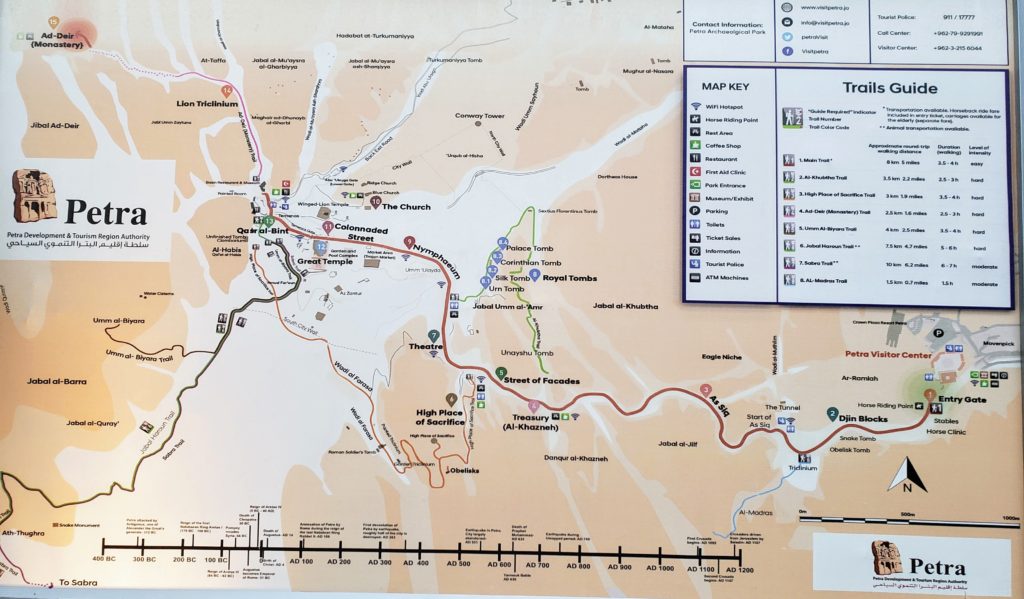
How to see Petra in 2 days
- Arrive the day before and if you can spend some of the time at the new Petra Museum. Get food e.g. pizza, fruit or make sandwiches etc. to take in to Petra with you the next day
It is important to get to Petra when it opens at 6am to beat the heat and the crowds, so arriving the day before is the key. We had booked an air bnb with a kitchen (as we always do) but discovered that it only had a sink, fridge and kettle, no cooking facilities. So, we had pizza for dinner and I put leftovers in my take-away container to take in with us the next day. Antony bought bread at a bakery to take instead. We did the same thing the second night, both ordering enough pizza to have leftovers for our second day in Petra. Having your own food inside Petra means you can eat when hungry and don’t have to walk from one end of Petra to the other to find the restaurant.
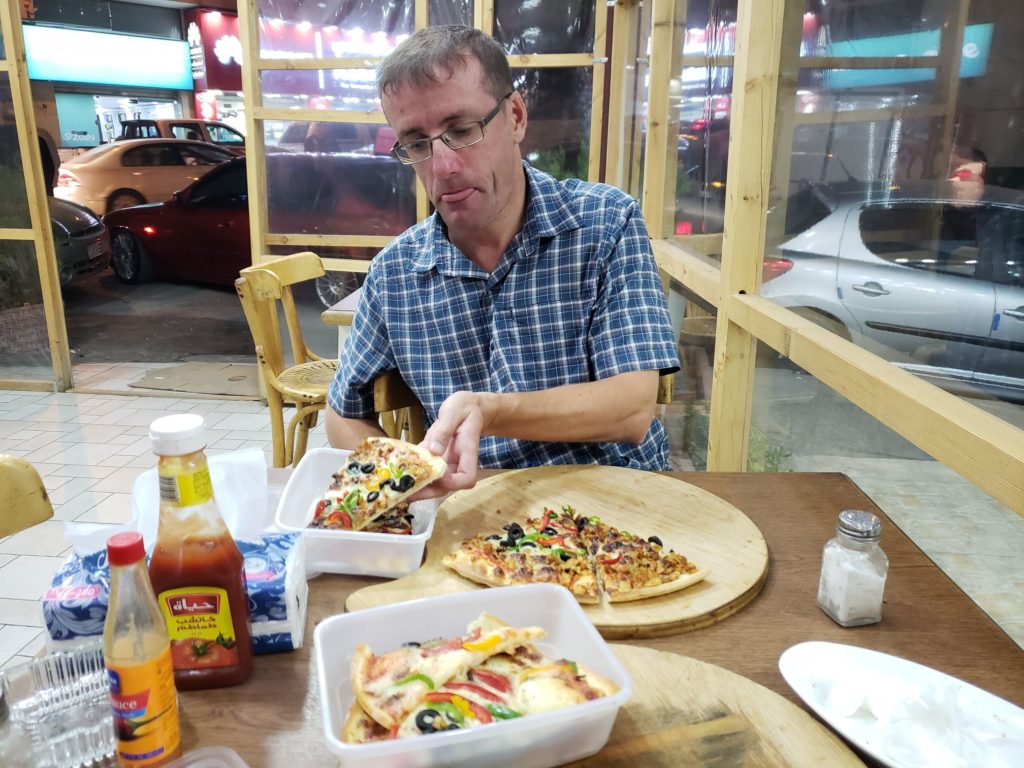
The newly opened (2019) Petra Museum is definitely worth a visit. We did this after coming out on our second day while waiting for our bus to Amman… but it would be best the day before you visit when you don’t have tired feet! That way you have some background info about the places you are seeing.
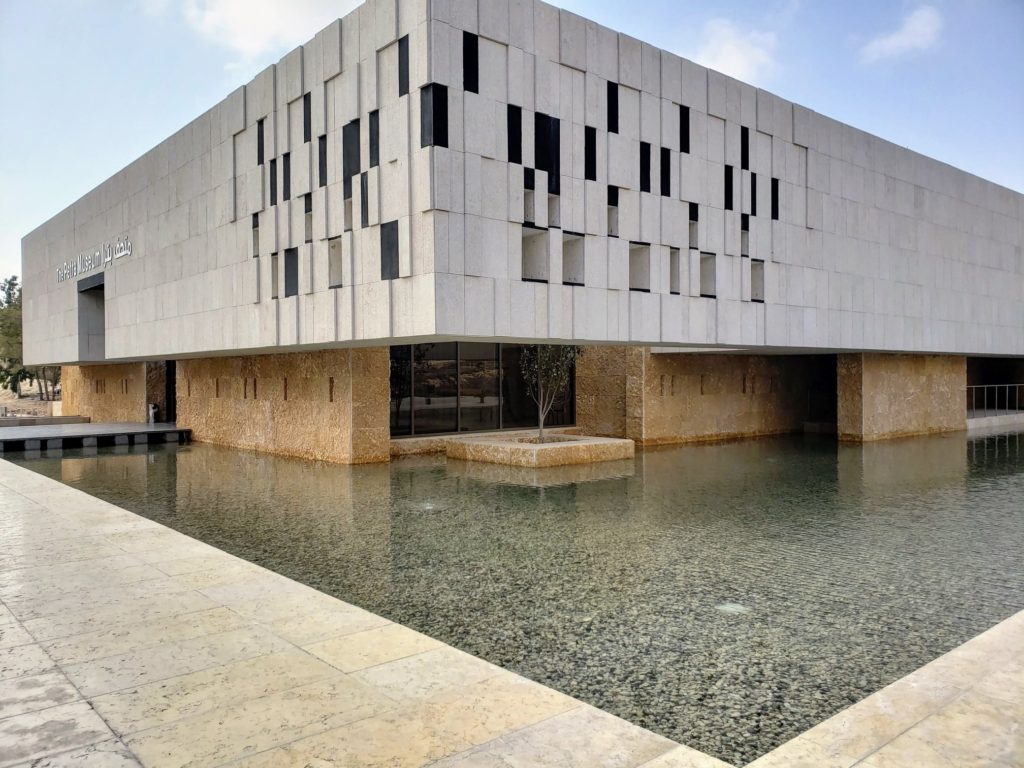
We particularly enjoyed the information about water technology / hydraulics of the Nabataeans. The Museum was free and beautifully laid out – with concise history and interesting artifacts found in the city of Petra. Here are a few (clockwise from top left); Medusa, 1st century CE, Hermes (Roman god, from Temenous Gate, mid 2nd century CE), Eye Idol representing a Nabbatean- Arabic goddess, Elephant Capital from Great Temple 1st century CE.
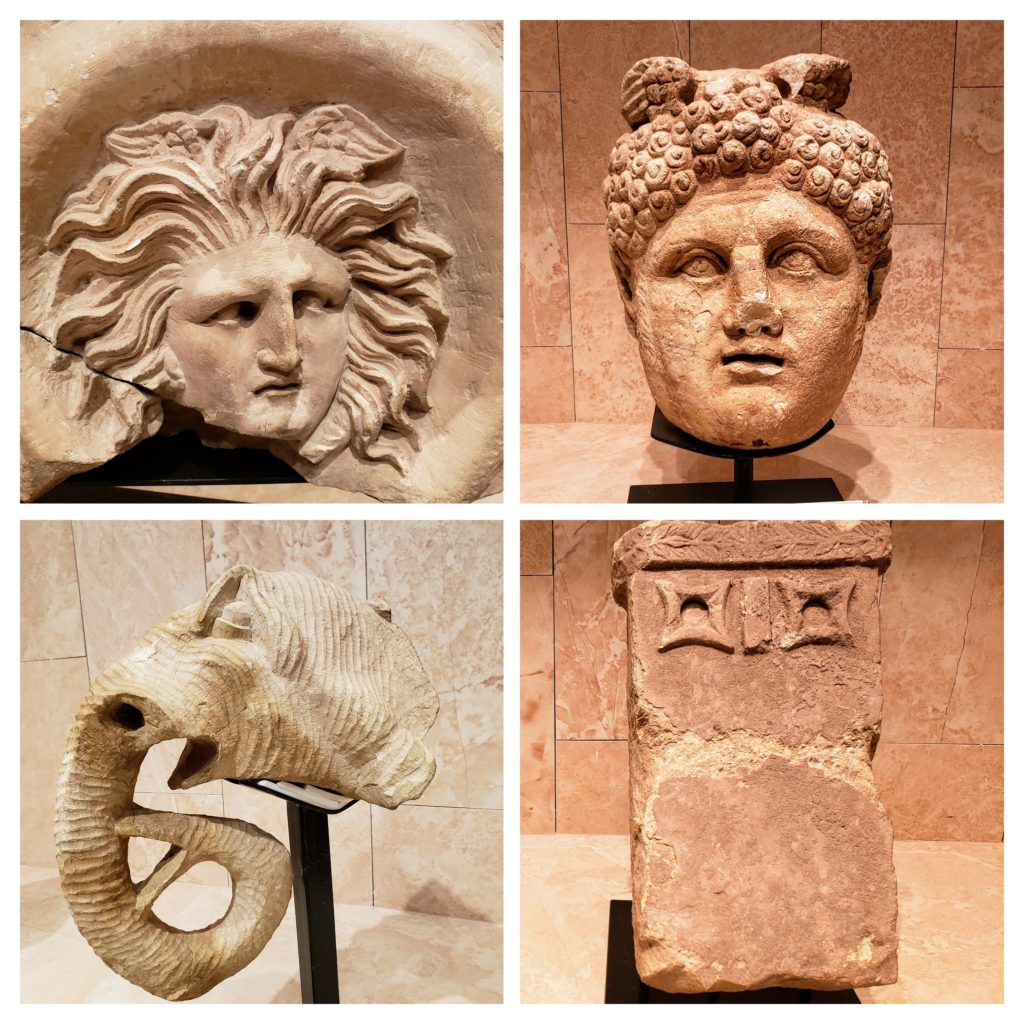
Day 1
- Arrive when the place opens at 6am, head to the ticket counter to show your Jordan Pass and get your Petra tickets. Once you have your ticket, head to the entry gate and from there it’s a 900m walk along Bab al Siq (gateway to the siq)- a walk along an open valley where you will see tombs and Djin Blocks before arriving at the Tunnel (right of the path) which marks the start of the Siq. Enjoy the walk through the Siq, the ancient main entrance to the city of Petra. Take photos now (later in the day when you leave it will be packed with people coming and going).
Skip to next bullet point if you just want tips for visiting or read on for our experiences and a bit of history in between bullet points.
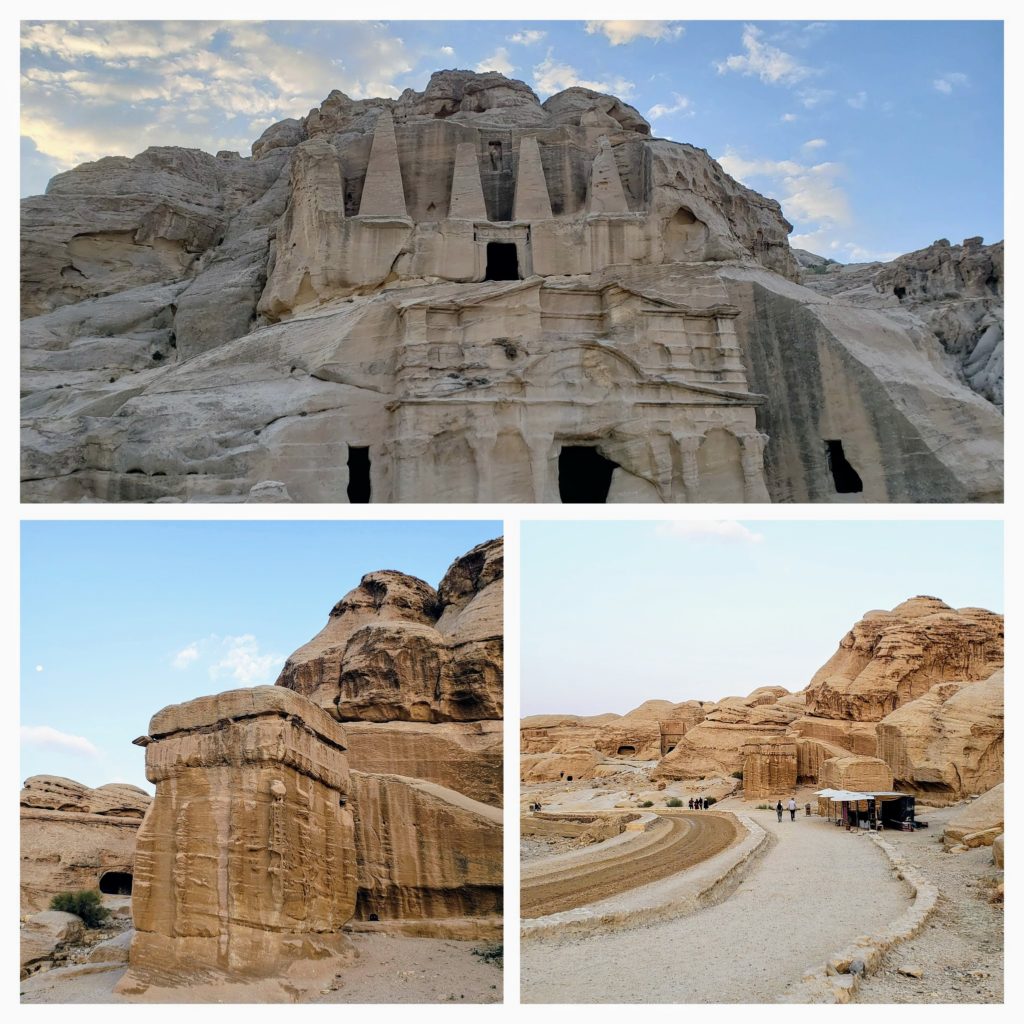
There is a lot of walking to be done exploring Petra – so you may want to hire a horse to take you along the valley to the start of the Siq. From there you can get a horse and cart through the Siq – we were there before they started in the morning so it was peaceful – but on the way out they were racing through, doing a roaring trade ferrying people back and forth. After the Treasury there are donkeys for hire to take you around the city. We opted for our own 2 legs and saved some $$ – but racked up a lot of kms each day!
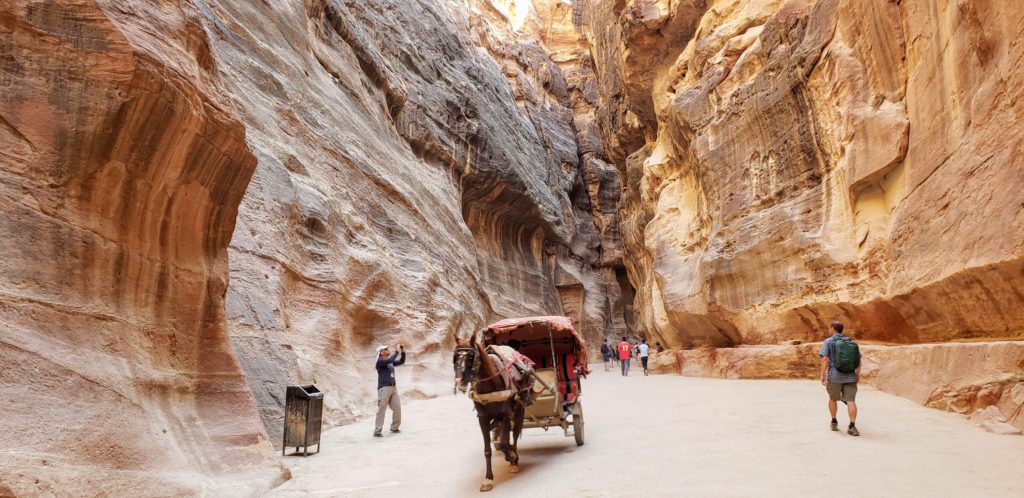
The Siq is the 1200m long entrance to the city of Petra. It is in places 3 metres wide, in others as wide as 12m, with the walls reaching heights of between 91 and 198 metres. It is mostly a natural rock formation but some parts were carved out by the Nabataean Arabs who founded the city of Petra in the 2nd century BCE (some sources say 4th century BCE). There is evidence of human settlement in the area dating back to around 9000 BCE!!
The Nabataean tribes established their own state during the second century BCE making Petra (known then as Raqmu) their capital. They created a dam to protect the city from flooding when seasonal rains hit. They then diverted water from the dam into a tunnel – it is this dam and tunnel (now rebuilt) that marks the start of the Siq.
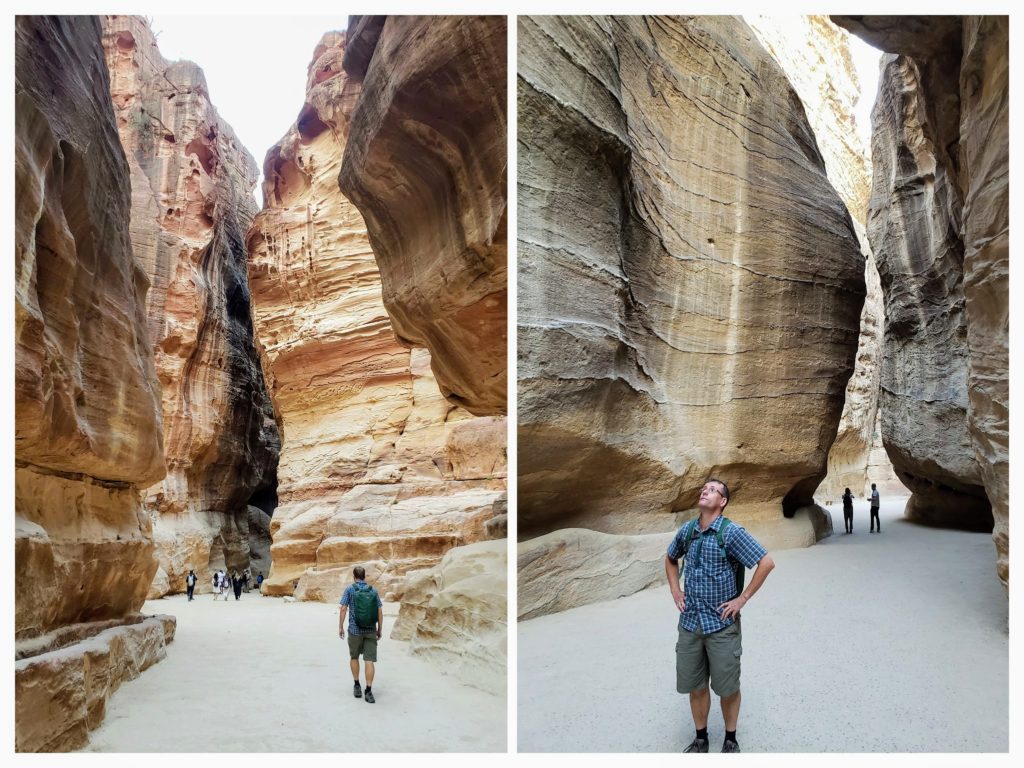
Can you see the water channel at the bottom of the cliffs on the left? It was cut out of the rock over 2000 years ago and was originally covered by stone panels. On the right side of the Siq as you head in, the Nabataeans used pottery pipes for the water to run through. The Nabataeans were some of the greatest hydraulic engineers of the ancient world. Thanks to the establishment of these water channels, drawing water from Wadi Musa and bringing it into Petra, the formerly nomadic tribes began to congregate and settle permanently.
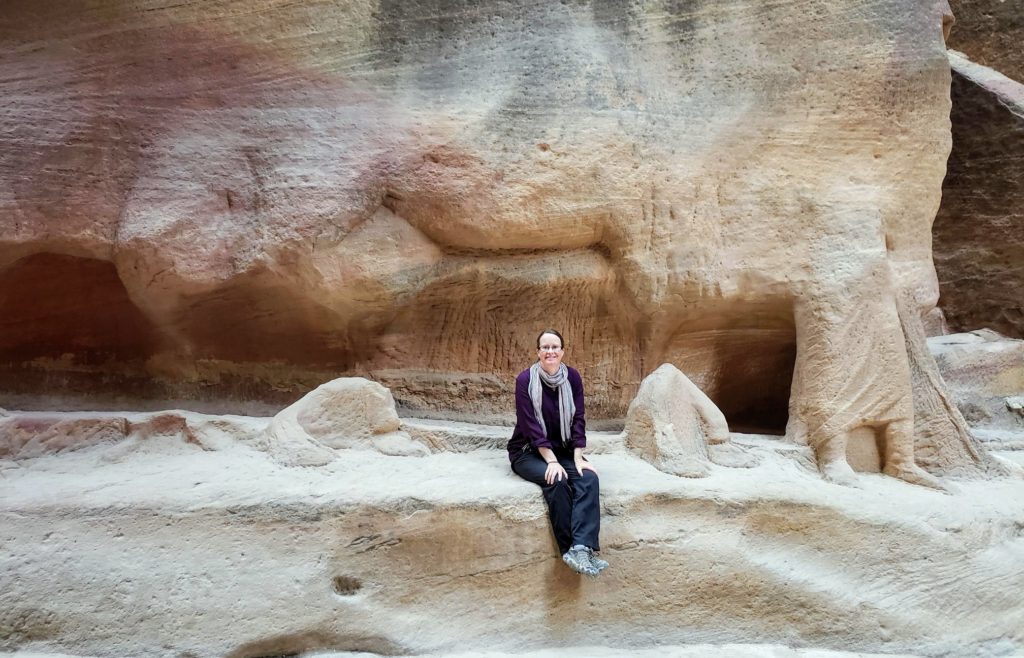
Pictured above was one of my favourite spots in the Siq – it’s eroded but you can still make out the larger than life driver of the caravan (at least his bottom half) leading the camels into Petra. Noticeable here the camels feet in front of the water channel and you can just see the body shape on the rock.
Caravans headed in and out of Petra on their way to and from the Arabian peninsula in the south to the Levant in the North, from China in the east and in to Europe. Petra’s strategic position meant it could monopolise the caravan trade in frankincense, myrrh and spices which it did for about 2 centuries. This lead to the Nabateans and their capital Petra growing in wealth and power during the first century BCE and first century CE.
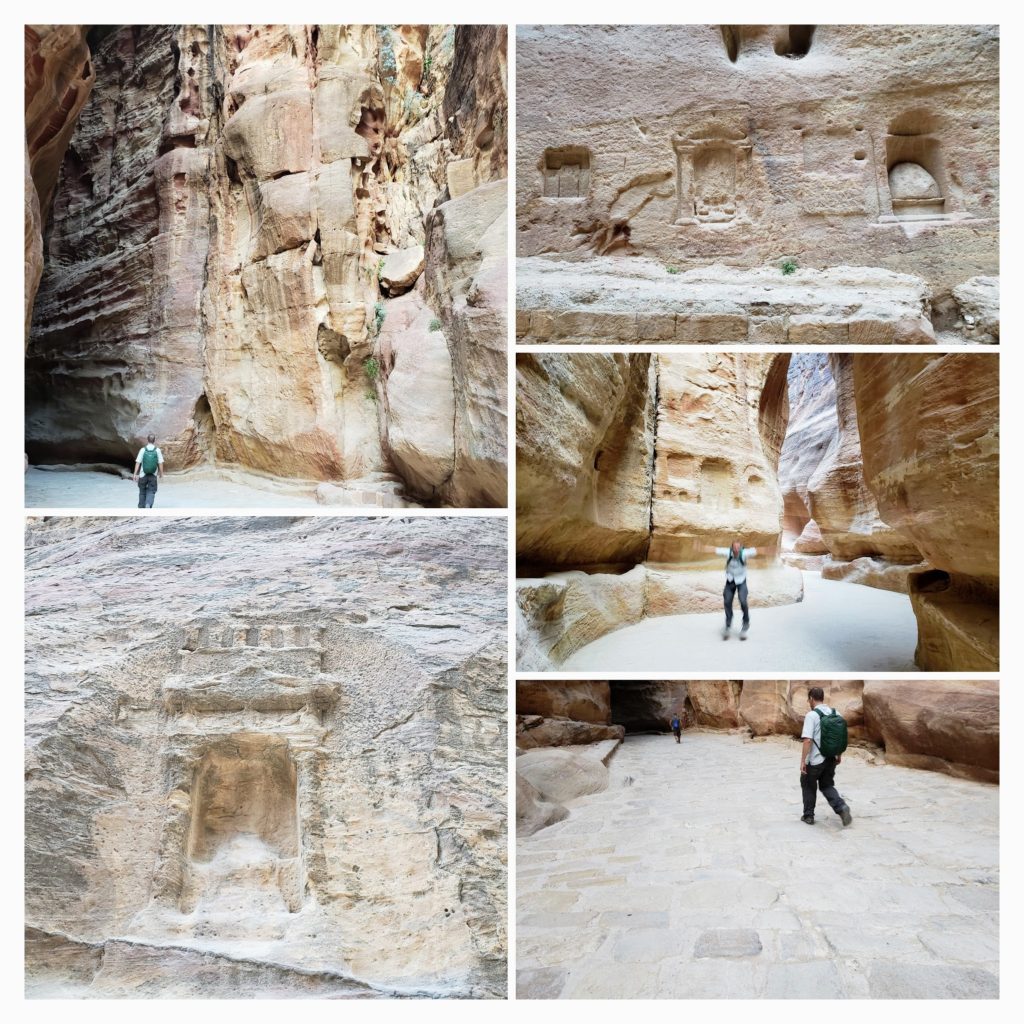
The whole walk through this narrow gorge is really cool – there are things to spot in the walls of rock – like an image of a fish, niches for worship and Greek writing. There are the water channels, the different rock formations and colours, stone steps going off to ancient worship spots and even the original paving stones in places. I loved walking on those paving stones and imagining who had placed them there and who and what had trodden on these same stones a good 2000 years before me.
At the end of the siq you get a glimpse of the Treasury – it is amazing to see it now but almost two millenia ago its beauty and scale must have really taken away the breath of those who arrived.
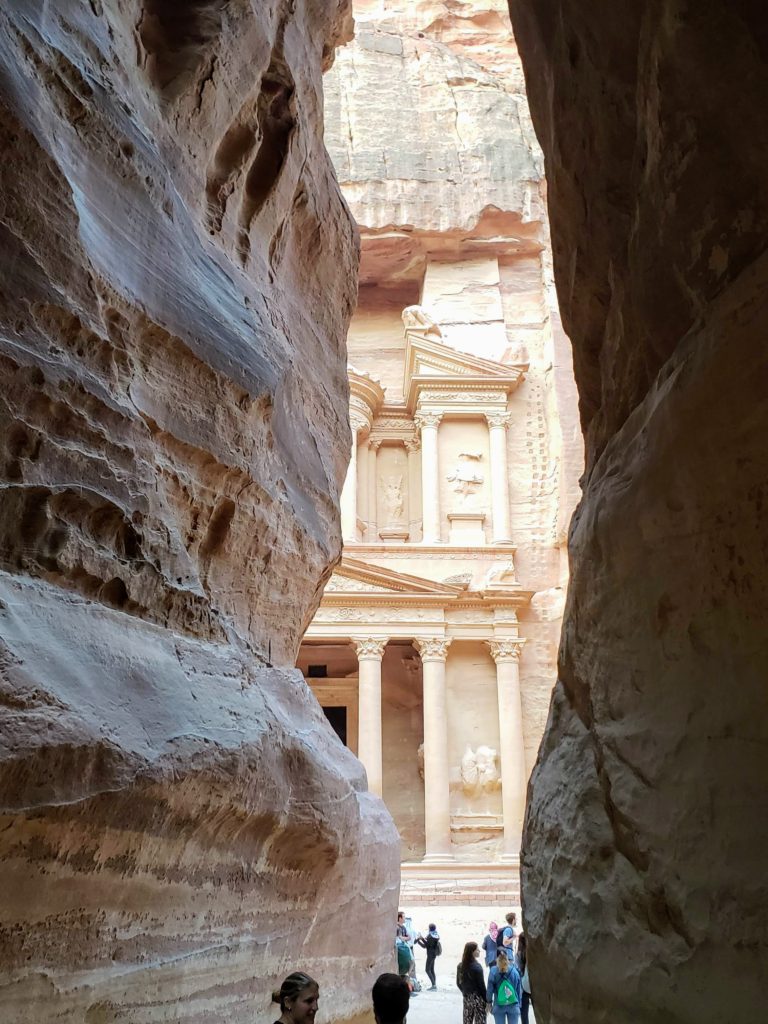
- After 1200 m of walking through the Siq and taking in the sights, be wowed by the Treasury. Enjoy this amazing place, take your time, take pics from in front and from one of the elevated viewpoints (easily accessible on your right)
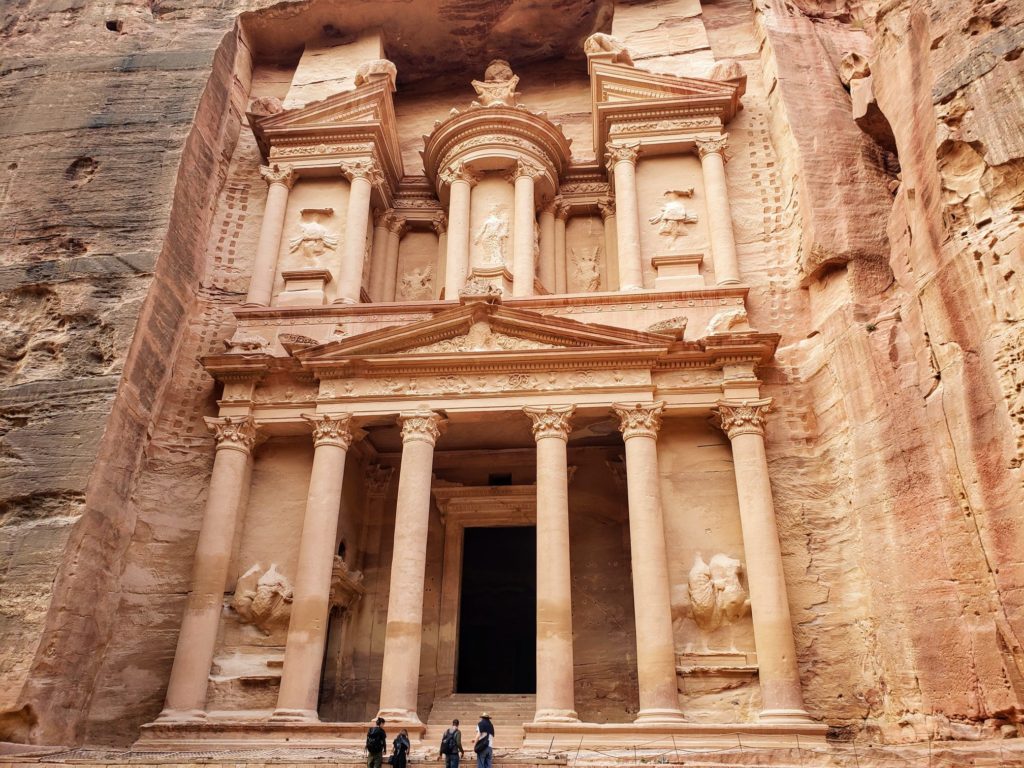
Not many people were here so early in the morning so it was nice to enjoy Al-Khazneh/ the Treasury in relative peace. This structure was carved out of the sandstone rock face in the 1st century CE. It was believed to be built as a mausoleum and crypt for the Nabataean King Aretas IV and despite its name was never a Treasury. Unfortunately local men at the start of the 20th century thought that the urn above the door housed some treasure and shot at it. You can see a lot of bullet holes in the solid stone urn.
It’s amazing this structure has survived so well despite earthquakes, bullets and the passage of time. See the people in front of it in both pictures to get a sense for how massive it is. Some of you may recognise it from Indiana Jones and the Last Crusade. In the final scenes Harrison Ford and Sean Connery emerge from the Siq and walk deep into the labyrinths of the Treasury in their quest to find the Holy Grail. In reality the impressive facade you see is all there is to see! It’s just a facade with a small hall inside that was once a tomb.
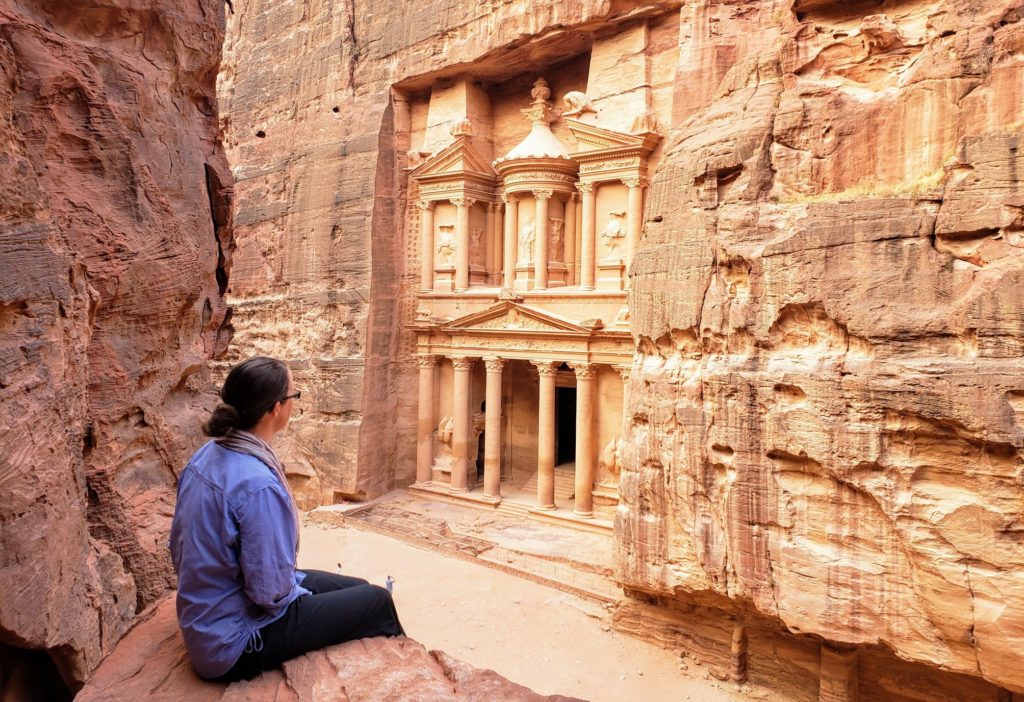
- Carrying on past the Treasury you’ll find Facades Street. Take in the cool facades and tombs here – there are many… so many! Some of the more prominent ones have information boards about them. These are mostly tombs of senior city officials and princes from the 1st century. You can go inside them.
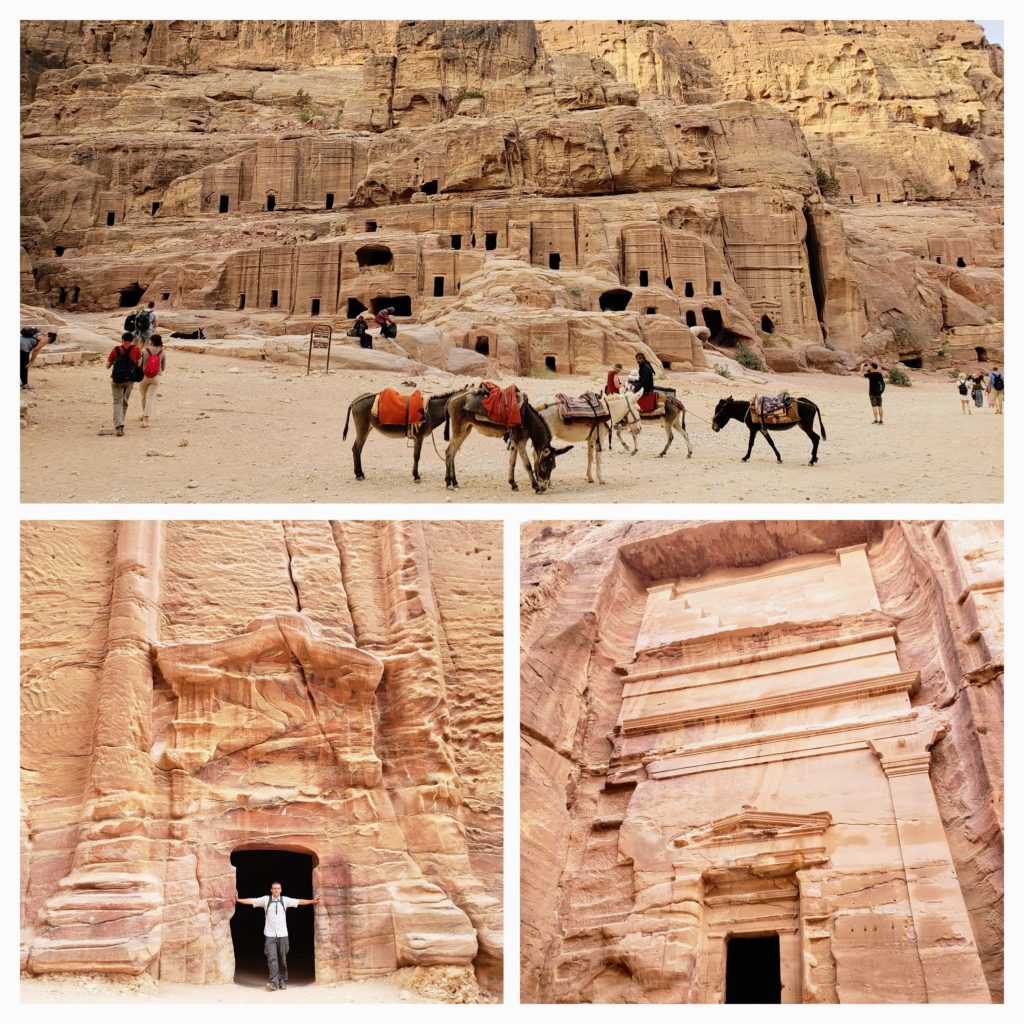
In 106 CE the power and glory days of Petra ended as the Romans formally took possession of the city. Its importance as a trade route waned. Earthquakes knocked the city back further and so too did the rise in importance of sea trade routes. Through the Byzantine era Christian churches were built (we’ll see those later) but the city was in decline and by 700 CE Petra was all but abandoned except for a handful of nomads.
- Next you’ll walk past the Theatre, which was carved in the mountainside during the reign of King Aretas IV (4BCE – 27 CE) and could host 6000 people.
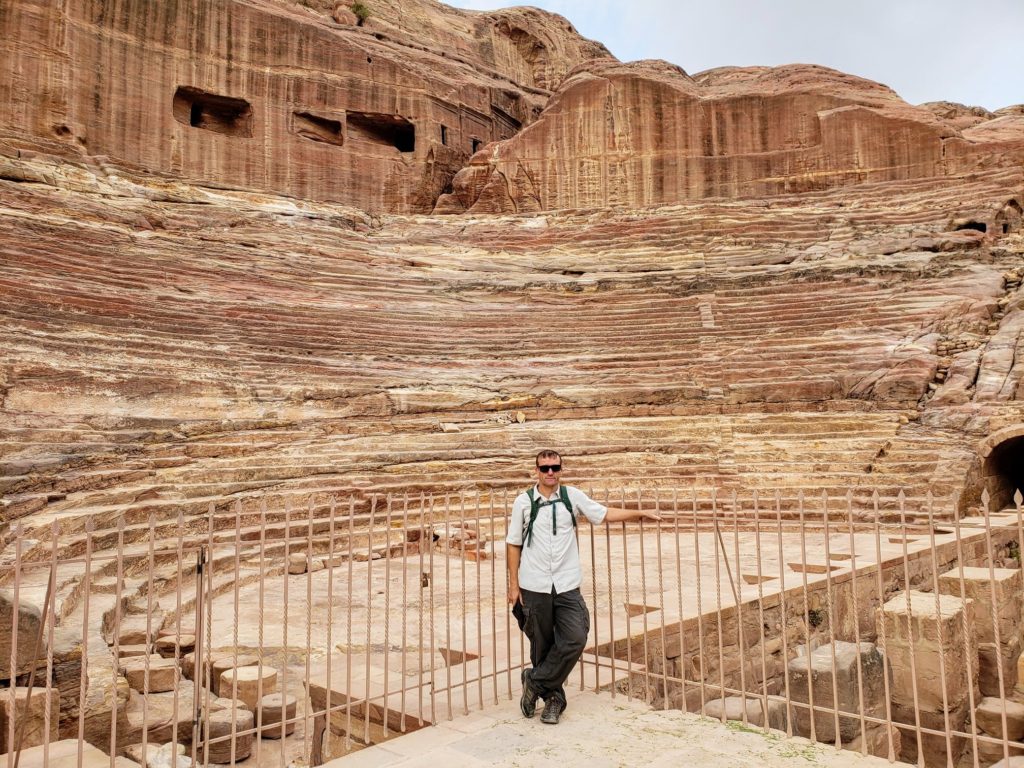
It gives an indication of how many people came here that a gathering place this large was necessary. Researchers anticipate it was used to host the many pilgrims, maybe where they conducted their rituals. It appears earlier facades in the mountainside were removed to make way for the theatre as the back of it shows the remains of a tomb complex. Romans later added a stage wall which shielded the orchestra and provided a theatrical backdrop. In Roman times it was likely used for musical and theatrical performances, poetry reading, athletic matches and public meetings.
- Walk along the Colonnaded Street, the main street of the city of Petra. It was rebuilt in 106 CE under the Roman occupation whereby the wide dirt and gravel road of the Nabataeans became a straighter, 6 m wide paved road with ornamental columns lining it.
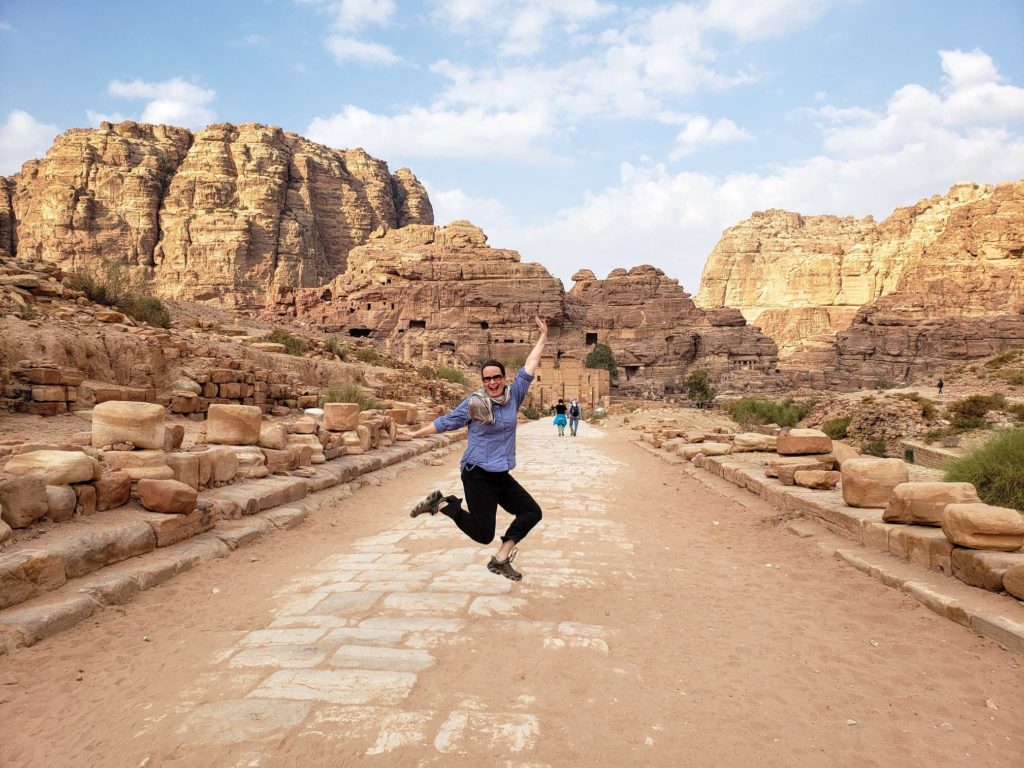
This main street probably hosted markets that traded goods such as frankincense and myrrh from Southern Arabia and East Africa, as well as semi-precious stones, textiles and spices from India. Some of the original Roman paving remains and you can get a sense as to how it sloped down on both sides to allow drainage of water to the network of channels below street level.
The thoroughfare was badly damaged by a devastating earthquake in 363 CE which toppled its colonnades and commercial buildings. The nine columns which are standing have been re-erected using the ancient column drums littering the street.

- Coming off one side of the colonnaded street is the Great Temple complex, built between 25 BCE – 100CE. With an area of 7560 square metres it is by far the largest freestanding building discovered in Petra.
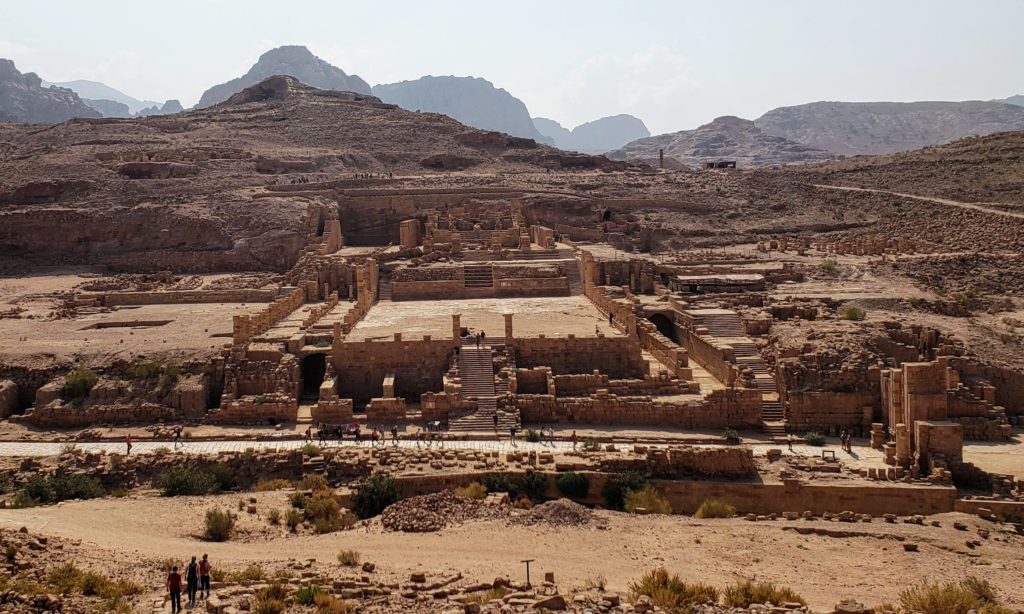
You can ascend a grand staircase from the street up to the first level of the Great Temple which had three rows of columns on either side of it. We sadly saw a tourist with a very young baby trip and fall down these stairs with the baby likely taking some impact of the fall. I sincerely hope the baby was unharmed – such a freak accident.
Although a temple, its likely function was more secular rather than religious. The religious temple was at the end of the street. This one was in the heart of downtown Petra, with two open air areas at different elevations – as you can see from the photo above, taken from a distance.
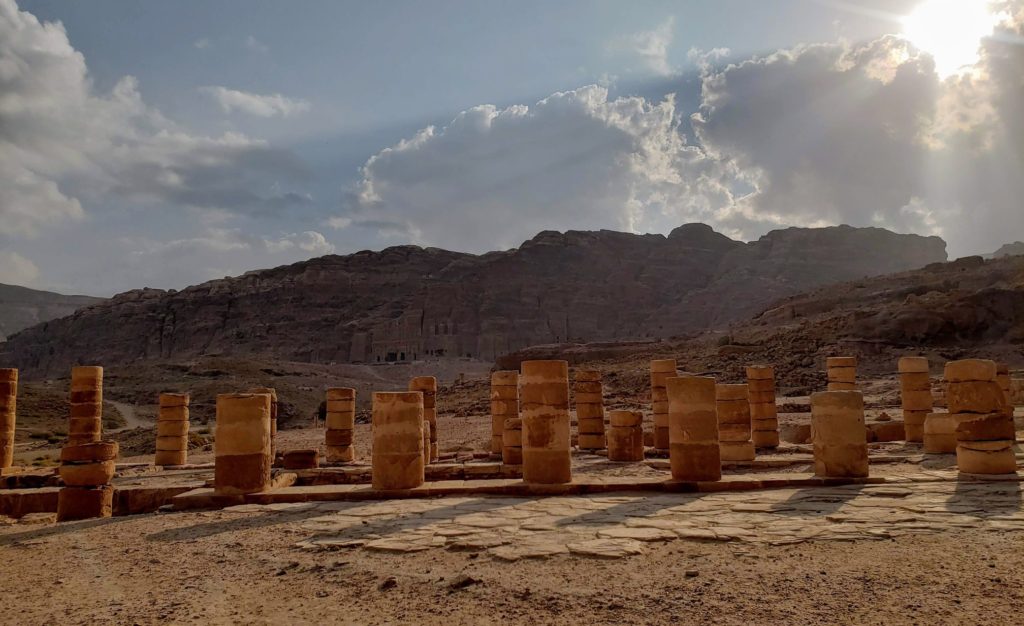
Excavations have revealed the back part of the building has a small open air theatre carved out of sandstone – researchers believe it was probably used as a council chamber or judiciary assembly hall. They’ve also found baths and an underground drainage system and a workshop that produced plaster molds. This all points to it being a civic centre rather than a religious temple. Was cool to see the elephant headed capitals on the lower level columns and the hexagonal tiling on the floor!
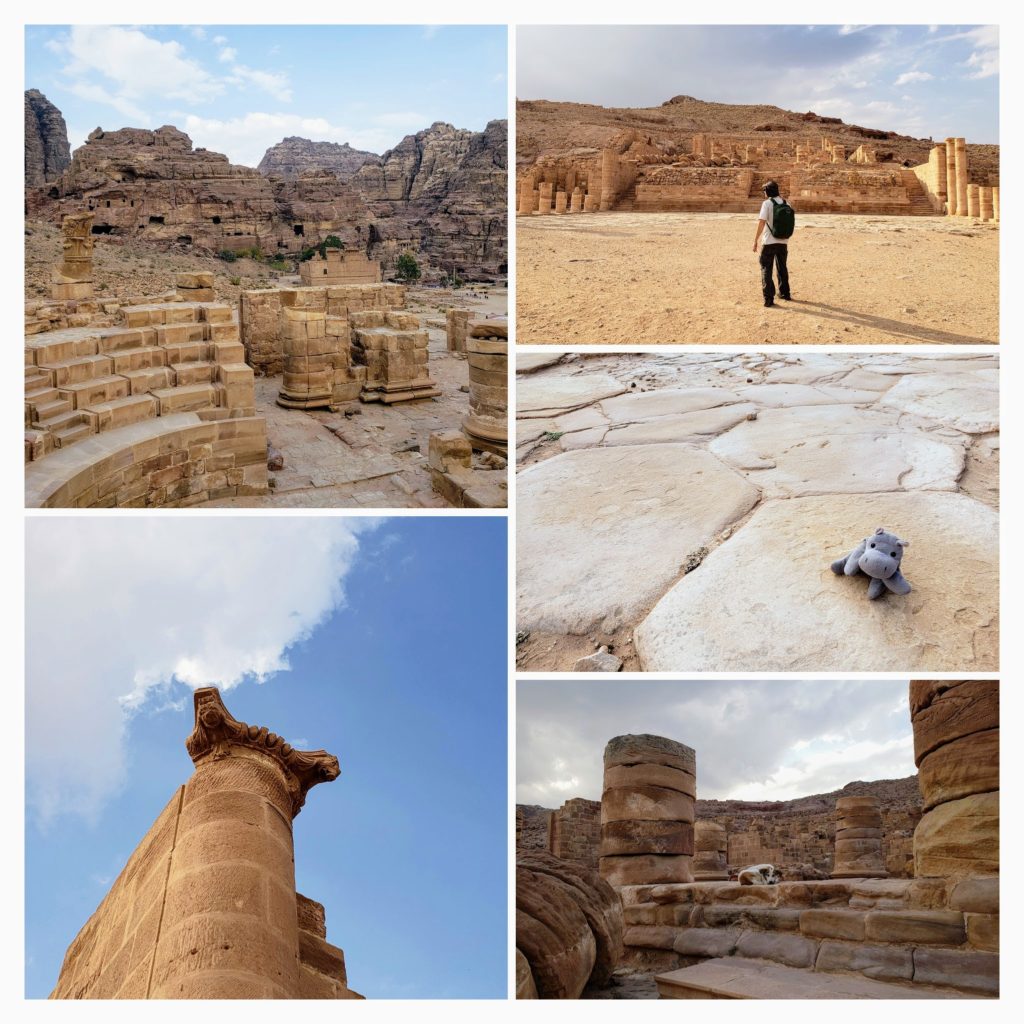
- At the end of the colonnaded street is the Temenos Gate, the monumental arched entrance way to the Temple precint of Qasr Al Bint. This gate collapsed in the earthquake of 363 CE but has been restored in modern times using ancient and modern sandstone blocks.

- After walking through the gate, on your left you will see the most important Temple complex in Petra, Qasr-al-Bint. Built between 25 BCE and 25 CE, it was a Hellenistic temple meaning only priests could enter inside and worshippers remained outside in the open temenos or holy area. It is possible that animal sacrifices took place here and that this temple was a pilgrim destination. It is believed this temple was dedicated to Dushara, the main Nabataean god.
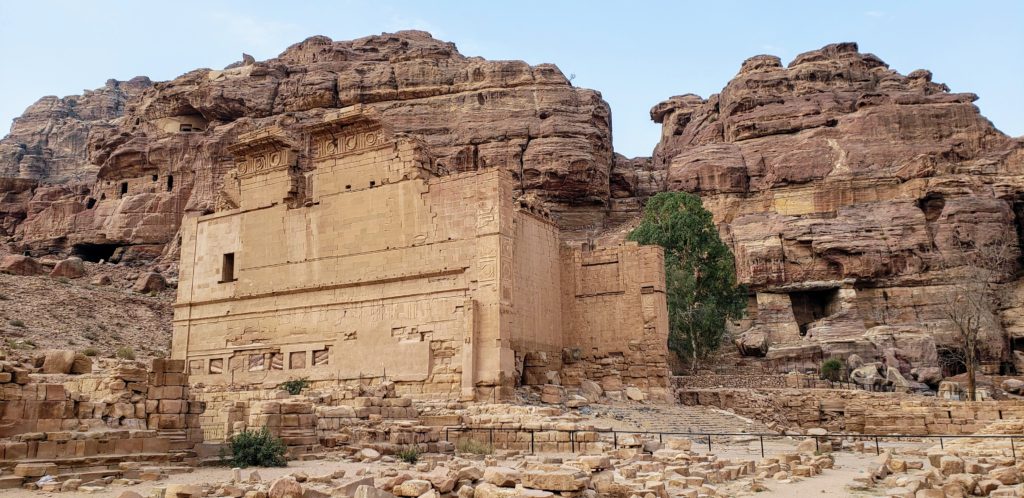
What is amazing is that this sizable built structure has withstood significant earthquakes. Researchers suggest its square, symmetrical plan may have helped, along with the use of wooden string courses along the lengths of the walls. Both the interior and exterior walls were originally covered in decorative plaster work, some of which you can still see.
In the photo below you can see some of the 27 marble steps leading up to the inner part of the temple. Columns with Corinthian capitals once stood near the top of the steps marking the vestibule.
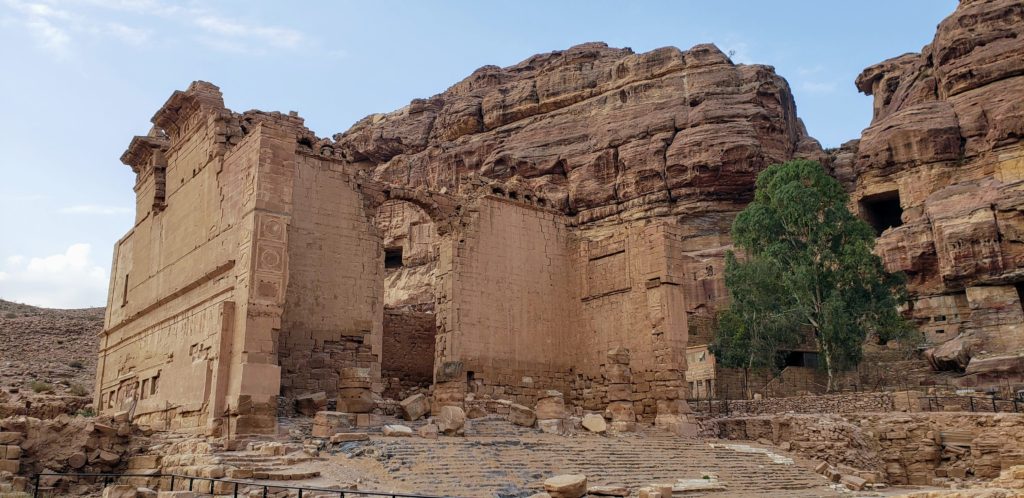
- Now after all that we get to the walk up the Ad Deir trail to the famed Monastery. Once you make it to this 2nd century stunner, relax and have some of that pizza you brought with you and explore the area if you’ve got the energy. It is quite a long and uphill walk to get there, but it’s fantastic. (Note: don’t hire the donkeys up or down).
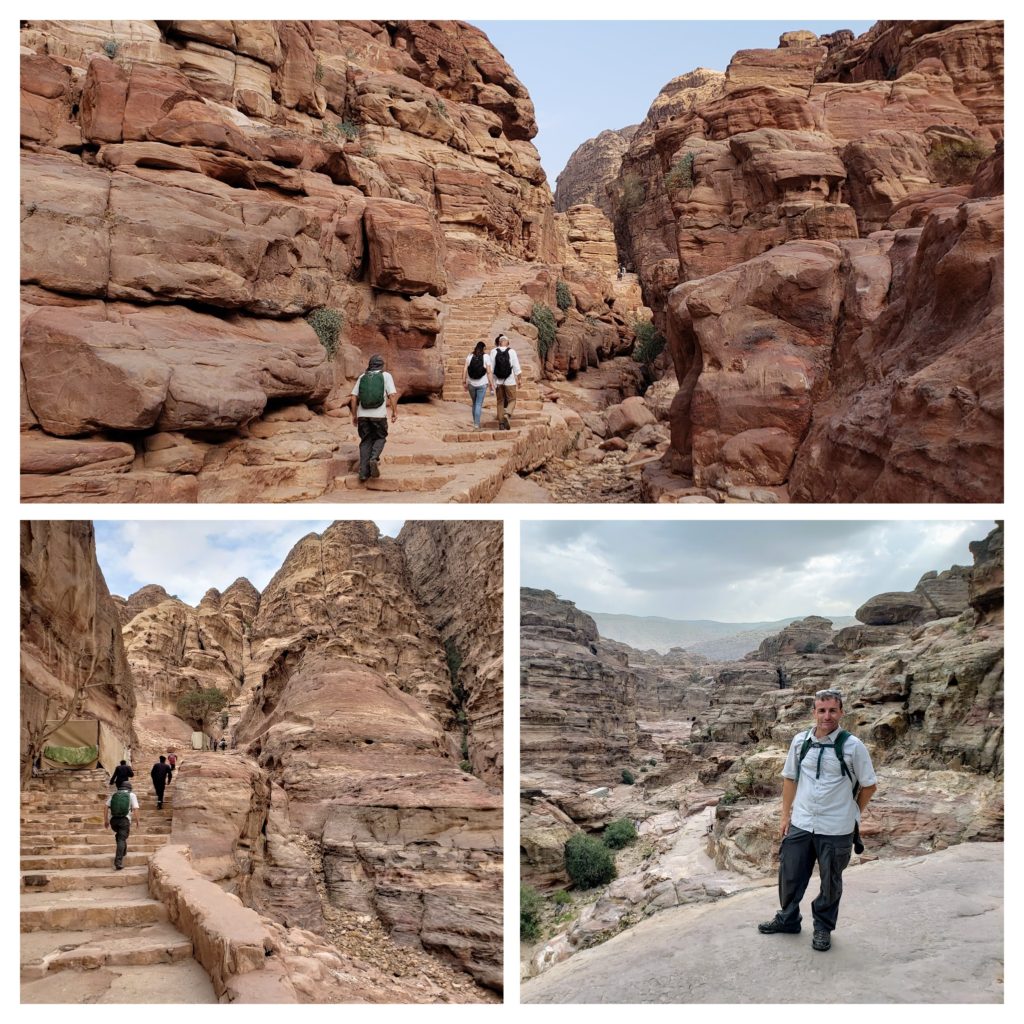
Like the Treasury, the Monastery was carved out of the hillside. It is huge – with a height of 48 metres and a width of 47m. Inside there are a couple of side benches and an altar against the rear wall. The hall was reused as a Christian chapel and crosses were carved in the rear wall – thus the name “The Monastery.”
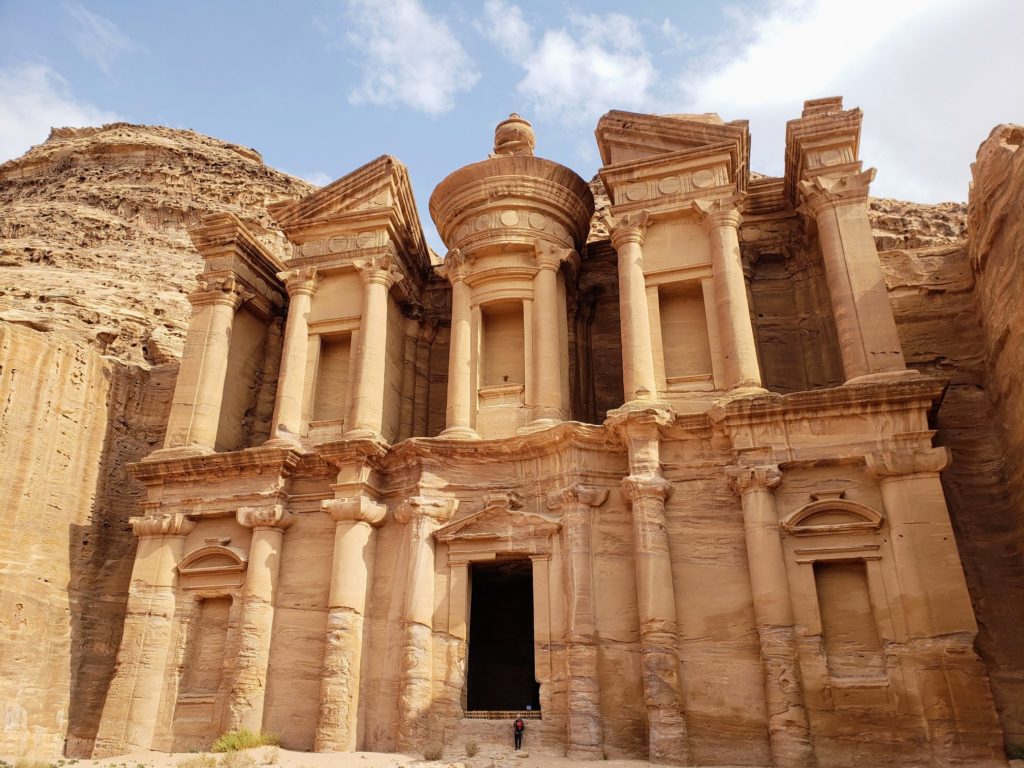
- Head back down again, taking in the Lion Triclinium off to your right near the end. There’s a bit of clambering to get up to inspect the lions at the entrance – not for the faint hearted!
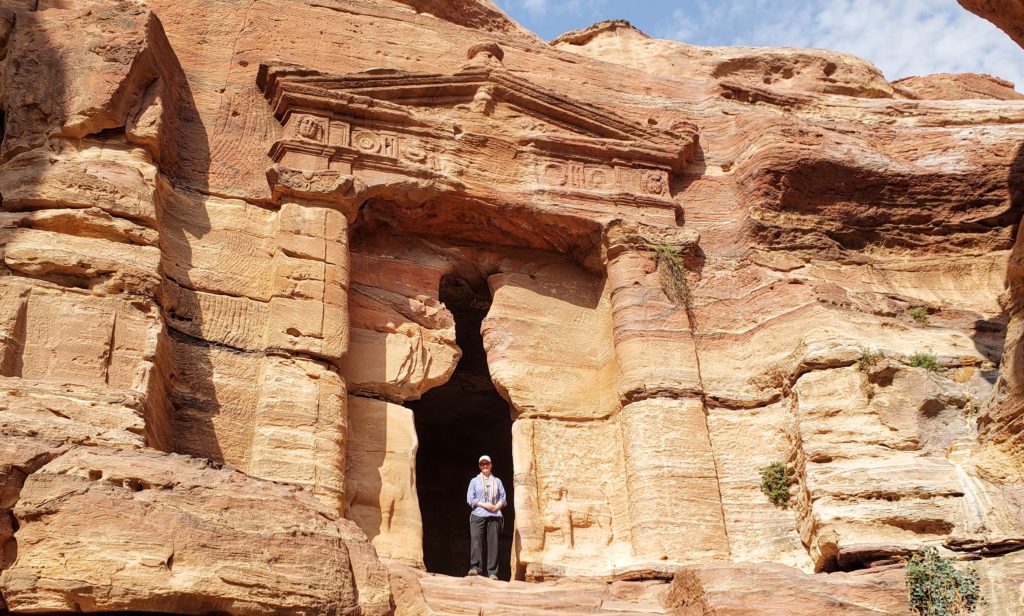
In the building itself there were no graves as it was used for ritual banquets. The name Lion Triclinium comes from the two, (now weathered) lions on both sides of the entrance door. There was once a round window in the upper area but that has eroded at the bottom making it look like the entrance had a keyhole design.
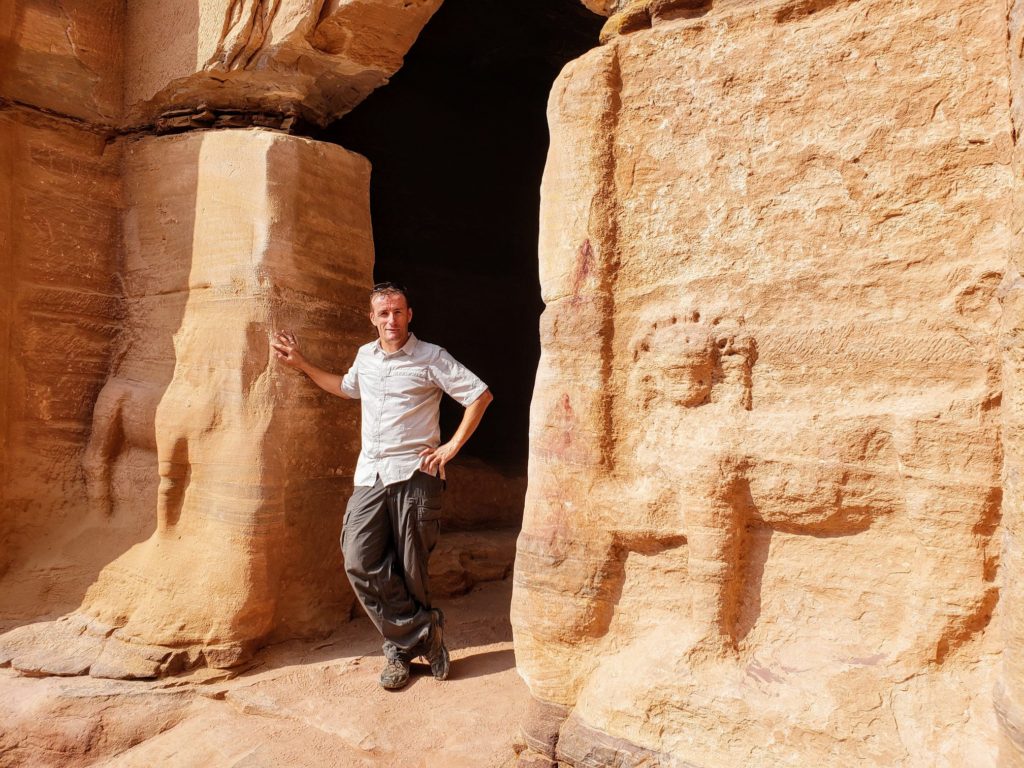
- Once you get to the end of the track (near the Restaurant and toilets) Instead of walking back along the same road, take the one on the left/ hilly side – that takes you to the Temple of the Winged Lions. This was a modest 1st century construction used to worship a goddess. Today what remains are a lot of columns. Interestingly attached to this temple were workshops – for grinding pigment, working marble, processing oil and hammering metal. There are great views over to the Great Temple, down the colonnaded street and to all the tombs at the end.
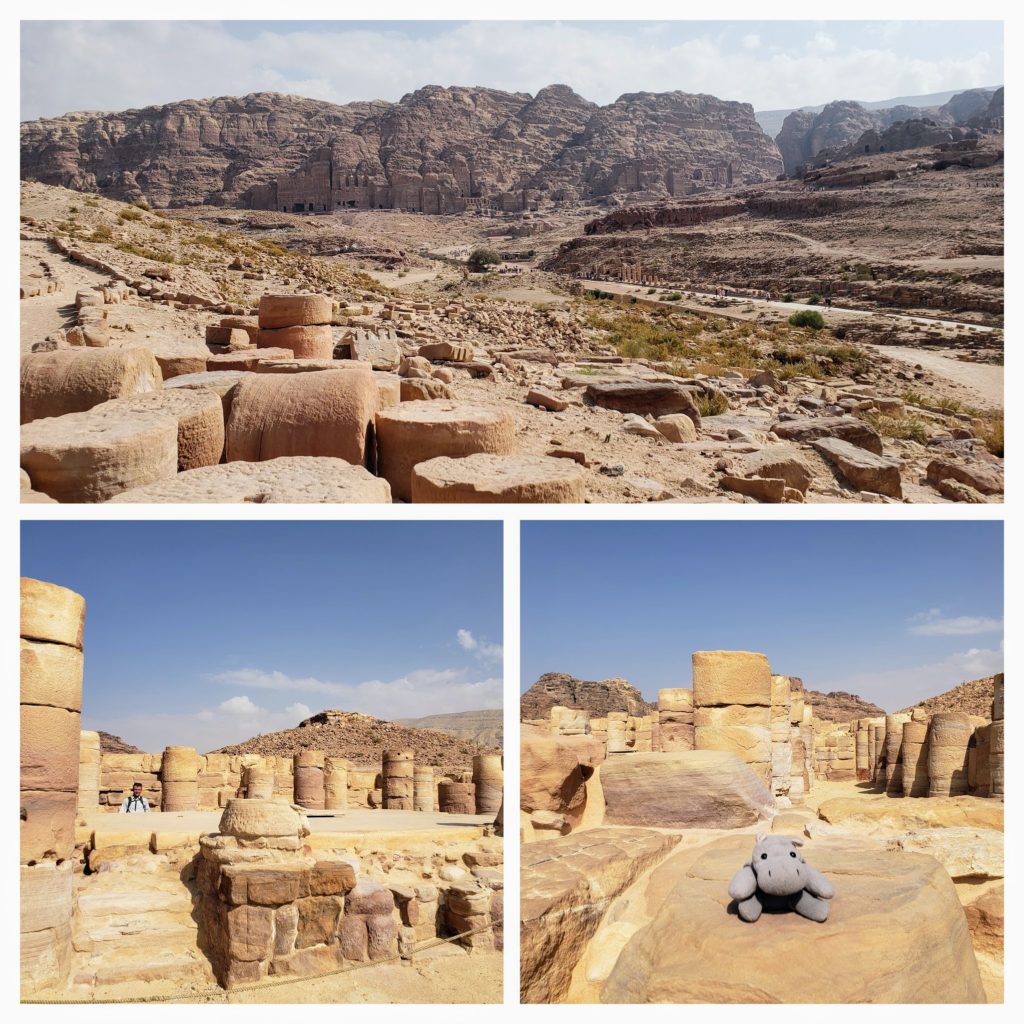
- Carrying along past these ruins and you get to the Church complex which was built and in use between 375 CE – 600 CE. It consists of the Petra Church, the Blue Chapel and the Ridge Church.
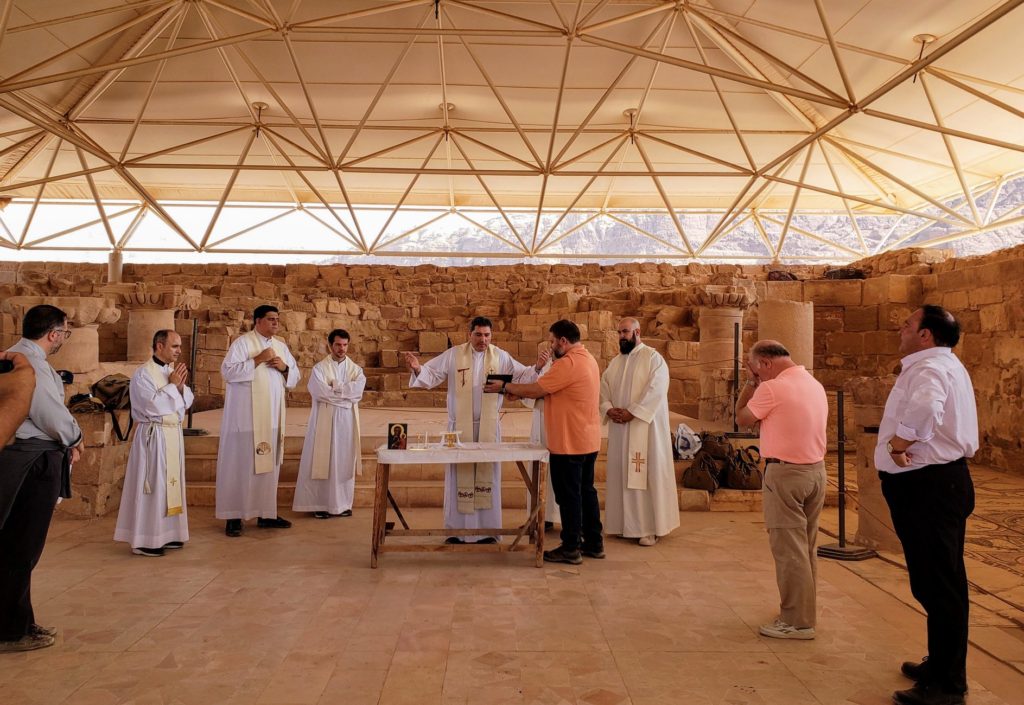
The Petra Church from the 5th century was most impressive with its mosaic floor still in tact. There were personifications of the four seasons, the ocean, earth and wisdom, also images of people, birds animals and plants. While we were in there, some Italians started having a mass! To protect the mosaics there is a protective roof built over the ruins. The mosaics are roped off to protect them – on the left and right side of the church.
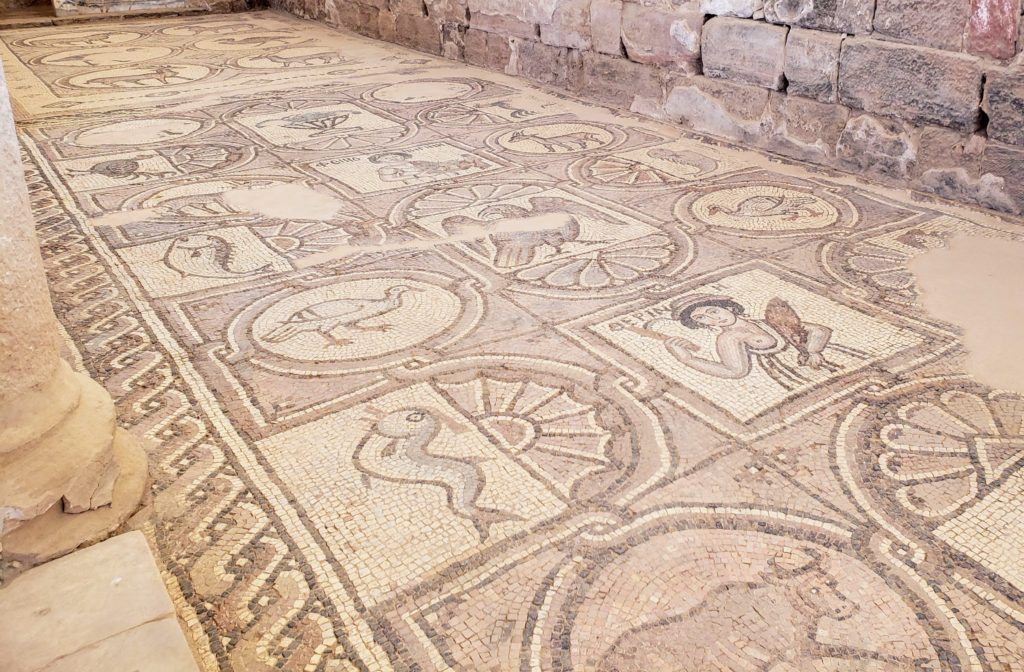
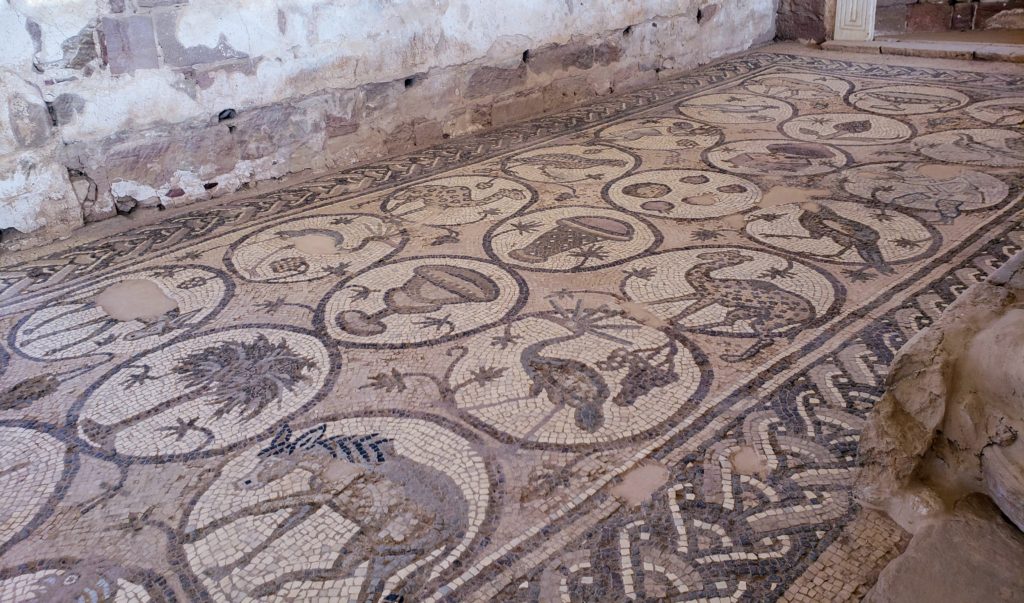
The Blue Chapel was named that way because of the 4 blue Egyptian Granite columns that were presumably moved there from a nearby Nabotaean monument.
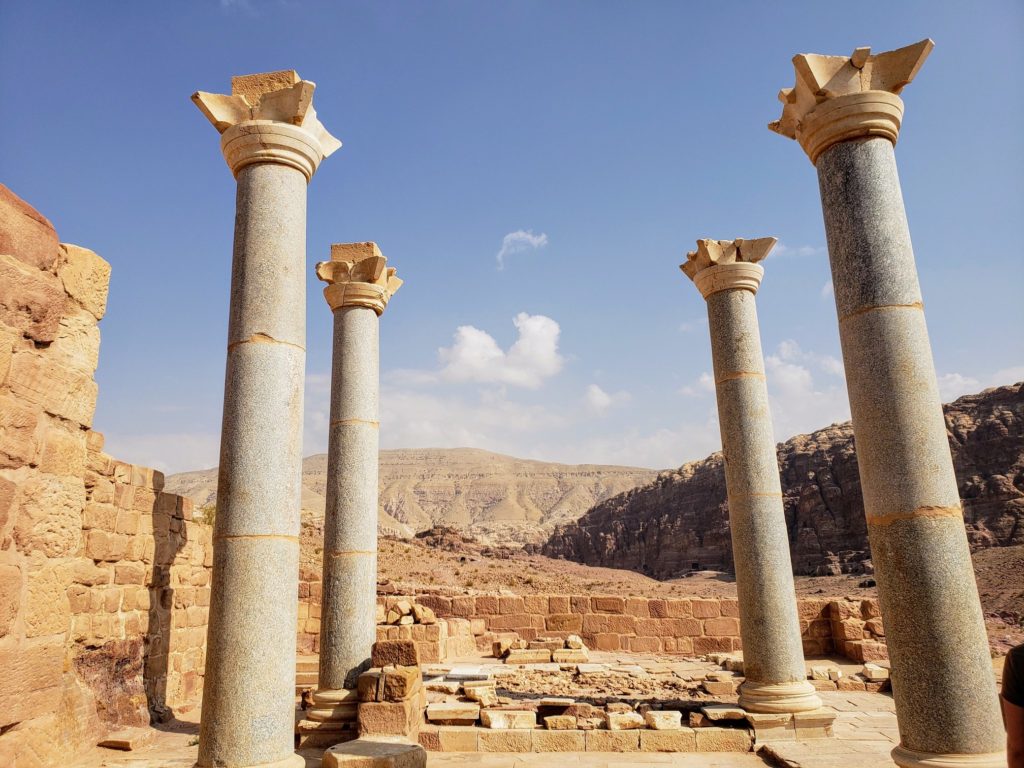
- Last but certainly not least it’s time to head to the Royal Tombs. Be prepared to be wowed at the swirls and colours in the rock – inside and out- and the design and size of the tombs.
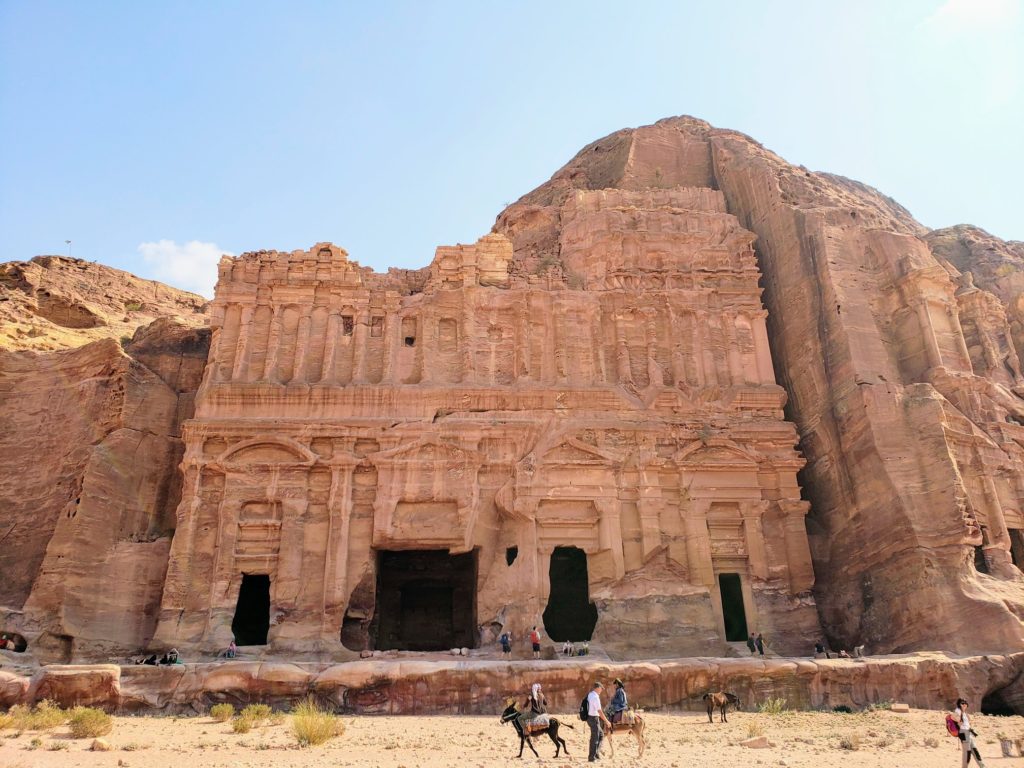
First we saw what’s called the Palace Tomb, which measures 49 m in width and 46 m in height. The lower part consists of 12 decorated columns and four gates which lead to four rooms for burial with some graves carved in the walls.
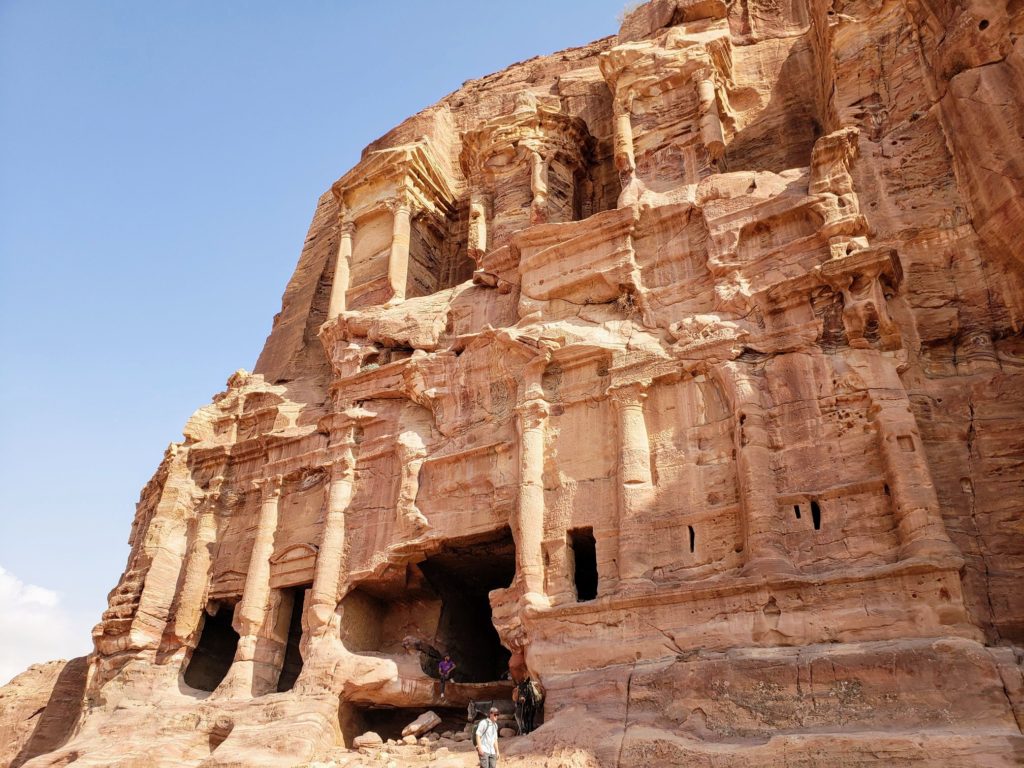
Although the Corinthian Tomb (above) is very weathered it is none the less impressive with a facade measuring 27.5m in width and 26 m in height. It bears similarities to the Treasury and was built between 40 and 70 CE.
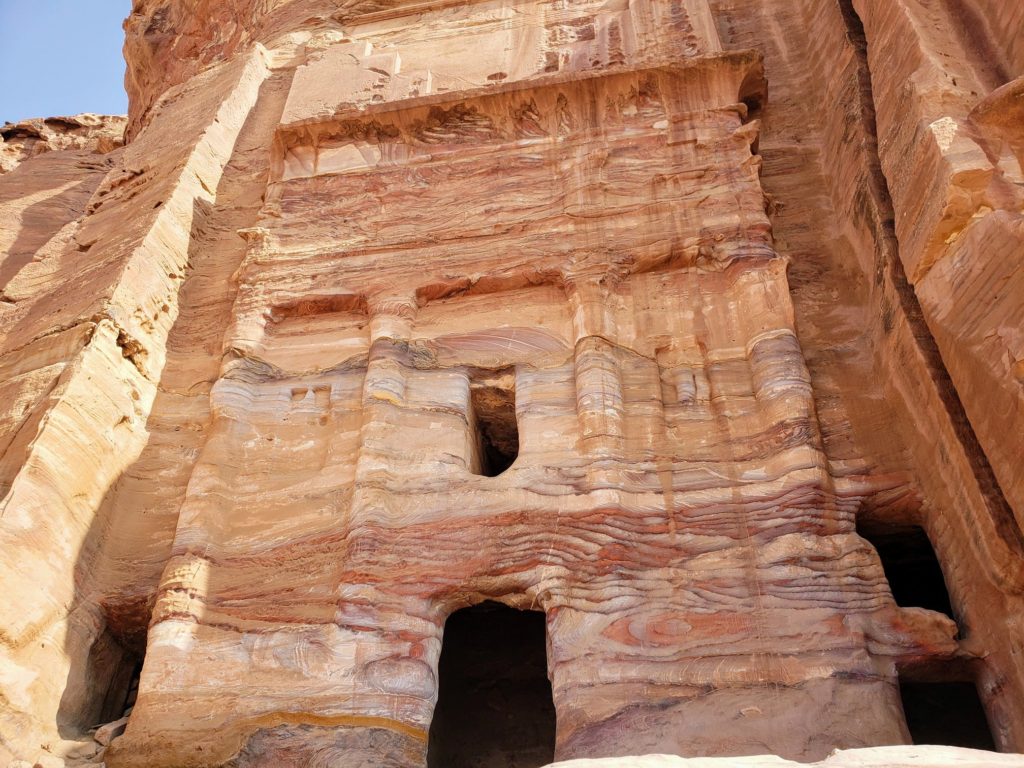
The Silk Tomb pictured above dates back to the first half of the 1st century CE. Its name comes from the majestic multicolored layers of sandstone that look like silk drapery over a tomb. It is one of the most dramatically coloured tombs in Petra.
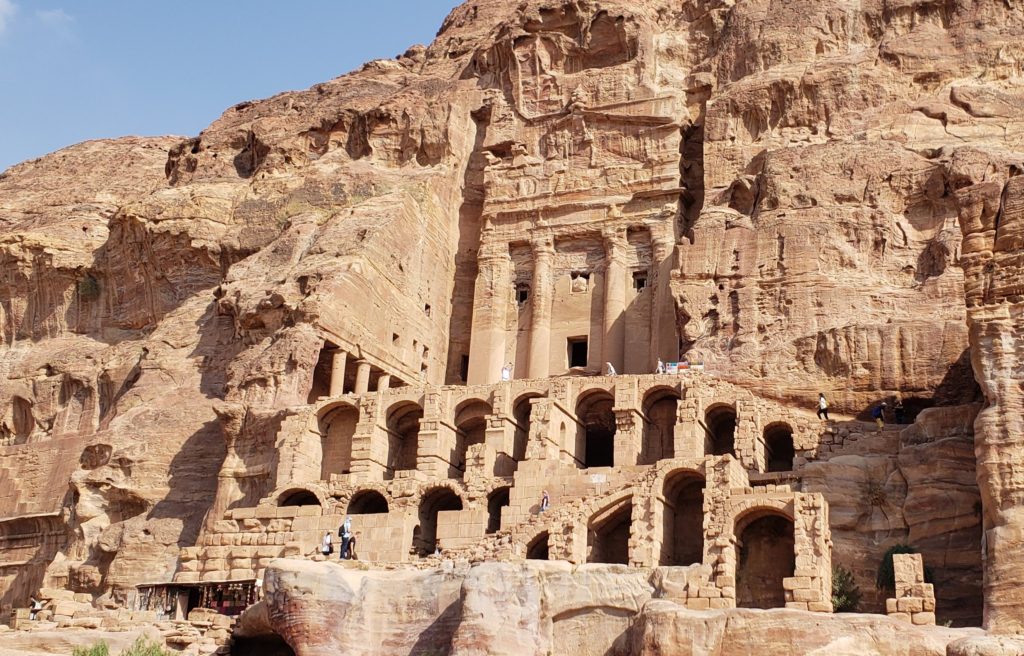
The most distinctive of the royal tombs is the Urn Tomb, pictured above… cut deeply into the cliff face around 70CE. After climbing a few staircases you get to a large courtyard flanked by impressive colonnaded porticoes. There is a very tall entrance to the interior… which has worn away nearer the bottom and above it you can see three inaccessible burial chambers.
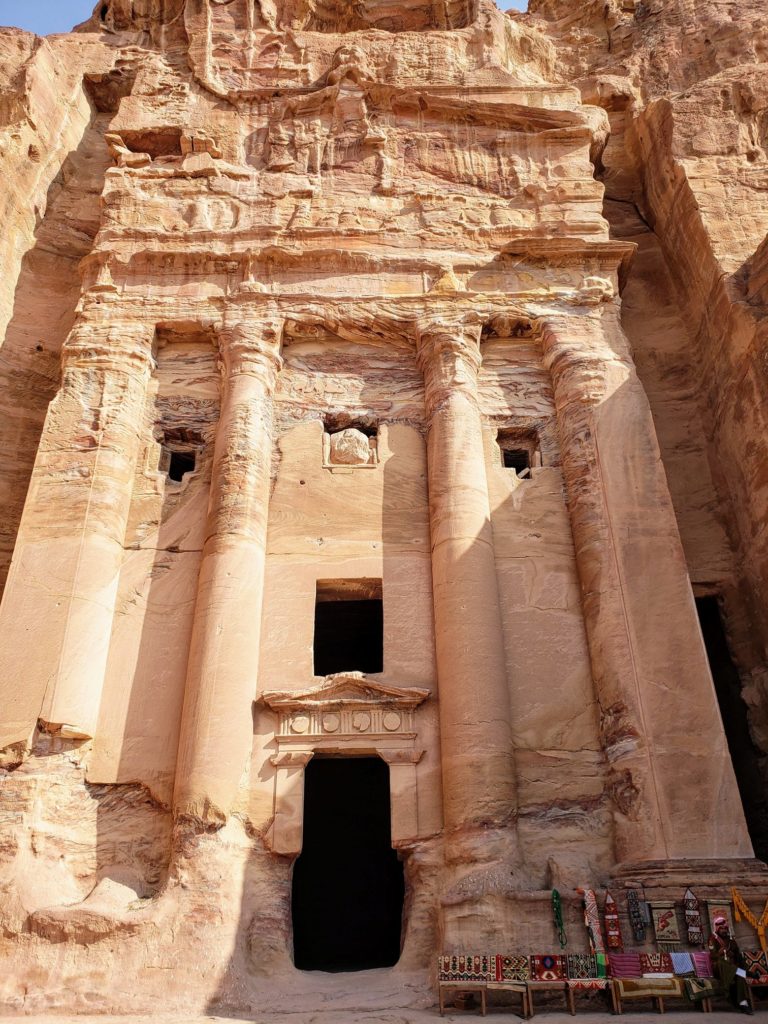
Given the tomb’s grand scale and pivotal location – it faces directly towards Petra’s main Temple Qasr Al Bint- this is believed to be the tomb of a King. Either King Malichos II (AD 40–70) or Aretas IV (8 BC–AD 40). The stone which seals his tomb has his portrait apparently! Too hard to see from down low though. The graves on either side of the king may have been used for the burial of his spouses or close family members. Here’s the view from the Urn Tomb:
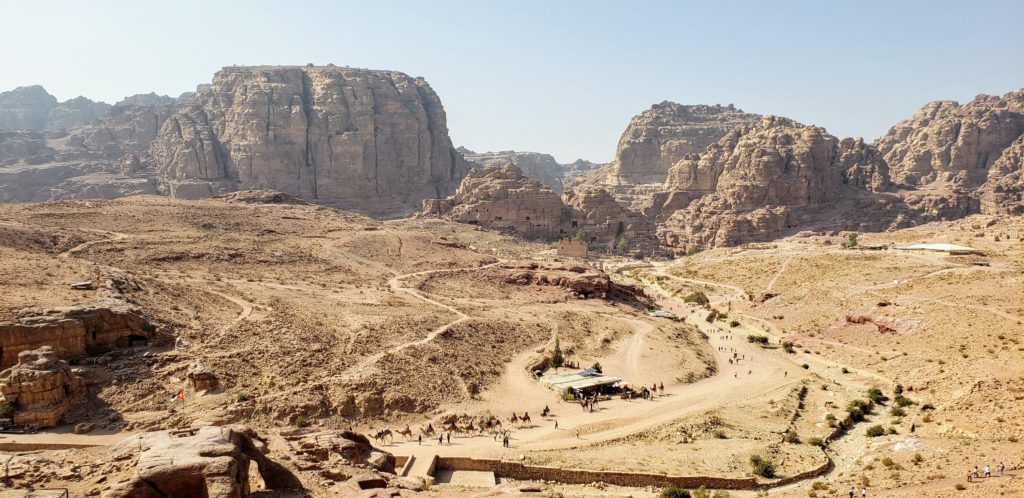
You can wander inside the 18m x 20m interior of the Urn Tomb and marvel at the natural colours and designs in the walls and in particular the roof. It’s a stunning space and not that surprising that Christians converted it to a cathedral. According to the Greek inscription on the wall, the space was consecrated as a church under Bishop Jason in 447 CE. It was around that time that the three arches you can see in the pic below were created in the back wall to form something of an apse.
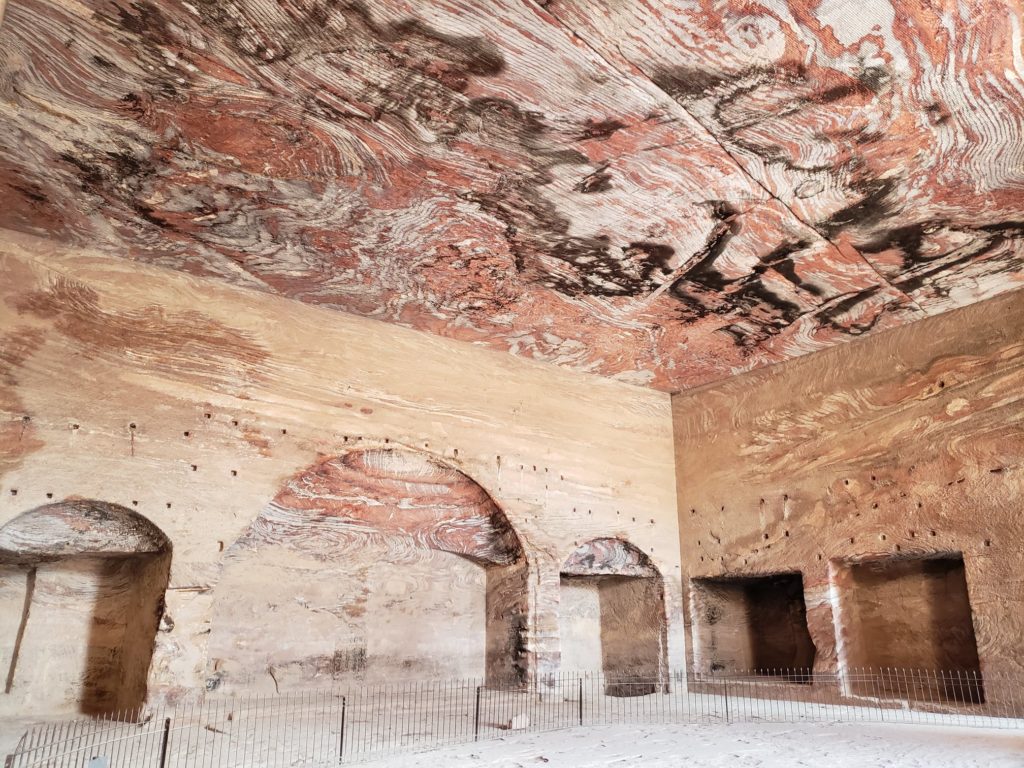
Not only was the interior stunning in natural patterns and colours but the view out the ‘window’ and onto the colonnaded portico was very cool.
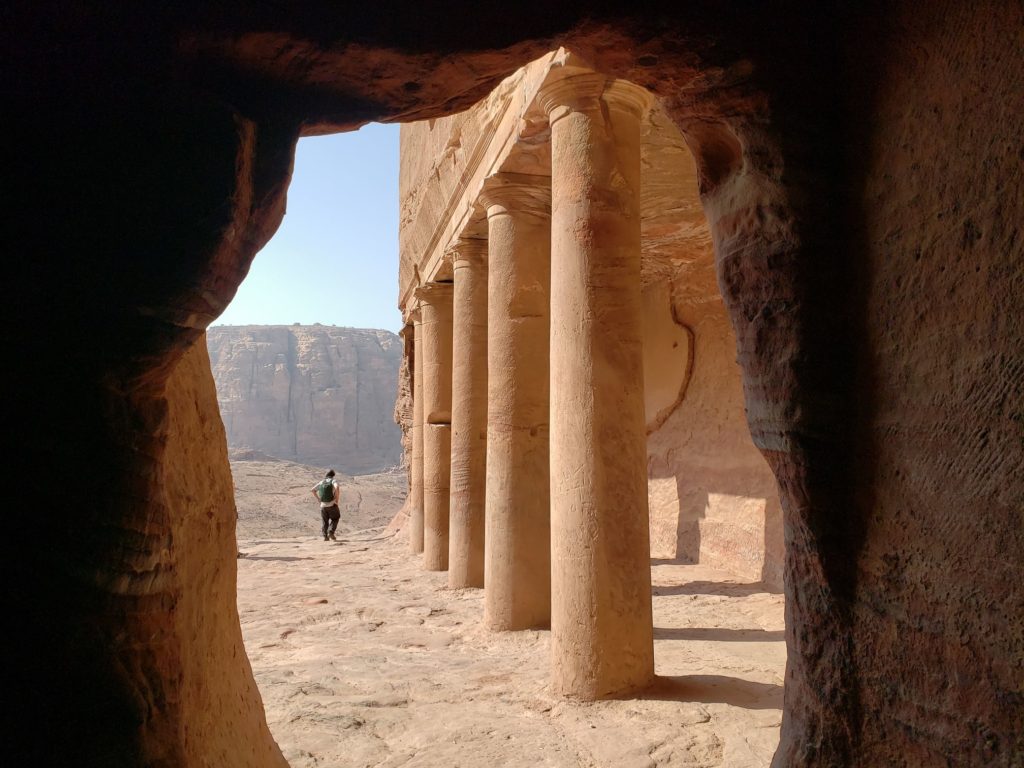
- You will probably be too hot and/or tired to do much more today so save energies for tomorrow’s adventures and head out the way you came, through the Siq.
Because of the early start to the day, we had our lunch super early in Petra and then were hungry enough to get a second lunch at 2pm when we got out. About halfway on the walk back from Petra to the main town, Jordan Heart Restaurant is on your left. We stopped here and thoroughly enjoyed our drinks and lunch.
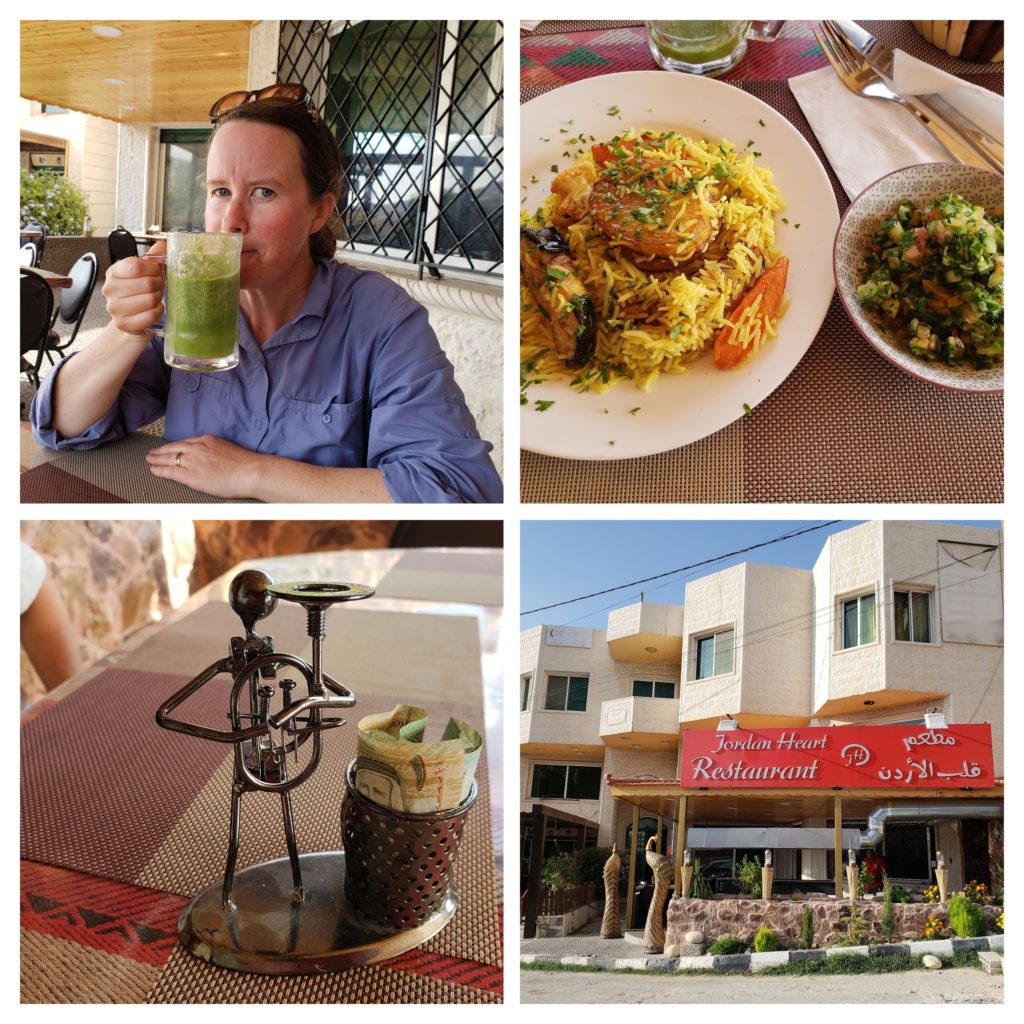
Congratulations if you made it this far!! What a massive post to reflect a massive Day 1 in Petra! Day 2 is next.